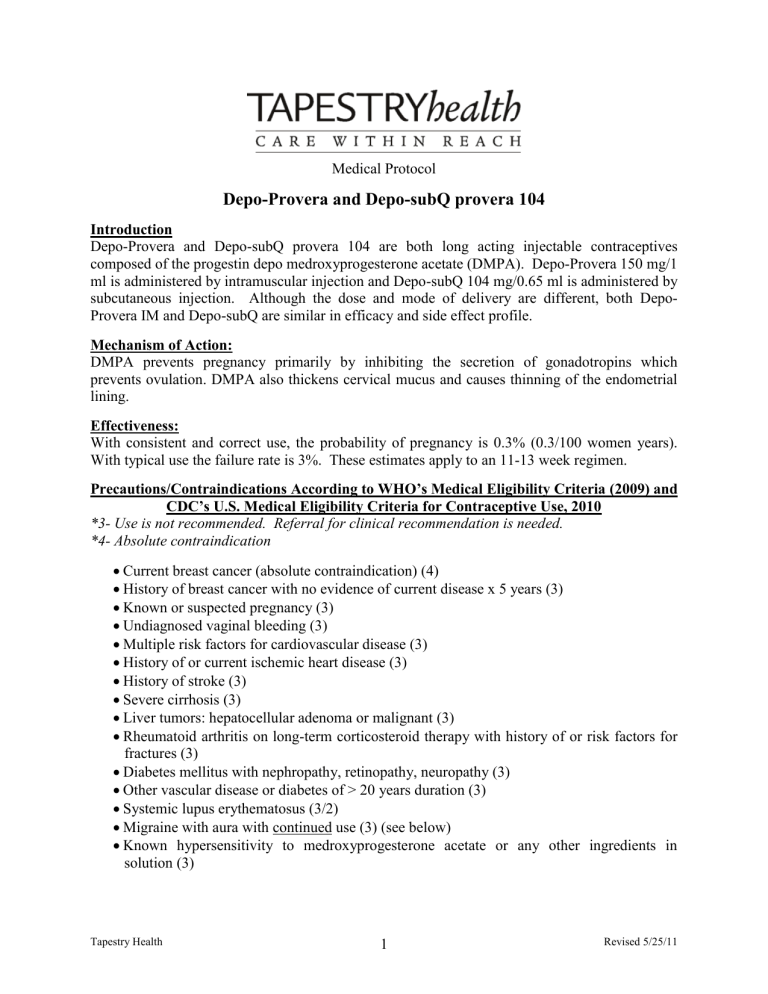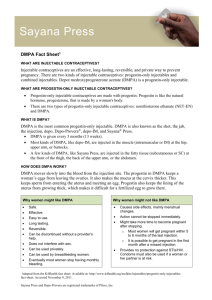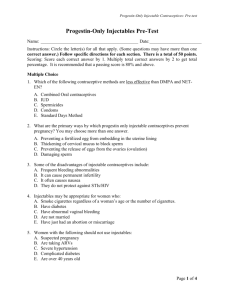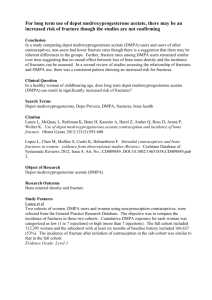depo-provera protocol - National Family Planning & Reproductive

Medical Protocol
Depo-Provera and Depo-subQ provera 104
Introduction
Depo-Provera and Depo-subQ provera 104 are both long acting injectable contraceptives composed of the progestin depo medroxyprogesterone acetate (DMPA). Depo-Provera 150 mg/1 ml is administered by intramuscular injection and Depo-subQ 104 mg/0.65 ml is administered by subcutaneous injection. Although the dose and mode of delivery are different, both Depo-
Provera IM and Depo-subQ are similar in efficacy and side effect profile.
Mechanism of Action:
DMPA prevents pregnancy primarily by inhibiting the secretion of gonadotropins which prevents ovulation. DMPA also thickens cervical mucus and causes thinning of the endometrial lining.
Effectiveness:
With consistent and correct use, the probability of pregnancy is 0.3% (0.3/100 women years).
With typical use the failure rate is 3%. These estimates apply to an 11-13 week regimen.
Precautions/Contraindications According to WHO’s Medical Eligibility Criteria (2009) and
CDC’s U.S. Medical Eligibility Criteria for Contraceptive Use, 2010
*3- Use is not recommended. Referral for clinical recommendation is needed.
*4- Absolute contraindication
Current breast cancer (absolute contraindication) (4)
History of breast cancer with no evidence of current disease x 5 years (3)
Known or suspected pregnancy (3)
Undiagnosed vaginal bleeding (3)
Multiple risk factors for cardiovascular disease (3)
History of or current ischemic heart disease (3)
History of stroke (3)
Severe cirrhosis (3)
Liver tumors: hepatocellular adenoma or malignant (3)
Rheumatoid arthritis on long-term corticosteroid therapy with history of or risk factors for fractures (3)
Diabetes mellitus with nephropathy, retinopathy, neuropathy (3)
Other vascular disease or diabetes of > 20 years duration (3)
Systemic lupus erythematosus (3/2)
Migraine with aura with continued use (3) (see below)
Known hypersensitivity to medroxyprogesterone acetate or any other ingredients in solution (3)
Tapestry Health 1 Revised 5/25/11
Although migraine with aura with continued DMPA use is rated as *3, headaches and migraines may be alleviated by the use of DMPA. Dr. Amsterdam does not recommend any prohibition on the use of DMPA in clients with migraines with aura. However, if migraine symptoms increase after the use of DMPA, a referral is warranted as well as discontinuation of DMPA.
Advantages
Highly effective
No estrogen
Reversible
Unobtrusive
Diminished or absence of menstrual bleeding
Reduced risk of ectopic pregnancy
Improvement in menstrual symptoms
Decreased seizures
Decreased sickle cell crises
Reduction in pain from endometriosis
Decreased bleeding associated with myomas
Improved hemoglobin levels
Decreased risk of PID
Subcutaneous injections may be less painful than intramuscular
Disadvantages/Side Effects
Menstrual cycle disturbances
Weight gain- 3.5 pounds on average over 1 year of use
Depression
Bone density decrease- temporarily and usually reversible
Headaches
Decreased libido
Nervousness
Breast tenderness
Skin rash/spotty darkening of skin
Hair loss/growth
Delayed return to fertility
Returned medical visits required
Indications
The appropriate candidate for DMPA use is a woman with no contraindications (as listed above), who wishes to avoid pregnancy for at least one to two years and is able to tolerate menstrual irregularities. She may wish to avoid coital-related devices and/or daily contraceptive methods.
She may be unable or unwilling to use a barrier method, IUD or estrogen-containing method, or she may prefer DMPA over other methods. She may also have issues of privacy, which makes use of DMPA highly desirable.
DMPA is an appropriate method for non-lactating postpartum and post-abortal women and can be started immediately after completion of the pregnancy. Postpartum women who are breastfeeding should not be given DMPA until 6 or more weeks after delivery to allow for establishment of lactation. Post-abortal women who do not receive DMPA immediately post-
Tapestry Health 2 Revised 5/25/11
abortion may receive it at their two-week post-abortion visit if they have had no intercourse in the meantime. (A pregnancy test conducted on a post-abortal woman at a two-week postabortion visit will likely still give a positive result and is not a true indication of pregnancy.)
HIV-positive women may use DMPA with no ill effect (other than side effects any user may experience).
Counseling
Proper advanced counseling of the client is essential to successful use of DMPA. Counseling will include information on the mechanism of action, mode of administration, effectiveness, advantages, disadvantages and side effects. In particular, it should be explained that if the client experiences side effects, these cannot be neutralized or reversed during the three month cycle.
Menstrual changes are universal in women using DMPA and include irregular bleeding, spotting
(lasting 7 or more days during the first several months of use) and amenorrhea. Approximately half of all women using Depo-Provera for one year experience amenorrhea. Menstrual changes are the most common cause for dissatisfaction and discontinuation of use. Proper counseling, selection, and follow-up should reduce client dissatisfaction. Medical intervention for irregular or heavy bleeding is rarely necessary, and anemia is uncommon.
Conception is usually delayed in women discontinuing DMPA when compared with women discontinuing oral contraceptives or IUDs. The median time to conception following the last
DMPA injection is 9-10 months. Within the first 12 months following discontinuation, almost
70% of former users had conceived and over 90% had conceived by 24 months.
DMPA is associated with a decrease in bone density. This decrease occurs most rapidly in the first 2 years of use and then slows dramatically. The decrease in bone density is thought to be temporary and reversible. Studies have indicated that bone density is regained when DMPA is discontinued. This also applies to teenagers who have used DMPA and then discontinued. The
World Health Organization concluded in 2005 that there should be no restriction on duration of use among women 18-45 who are otherwise eligible. For women less than 18 or over 45, the overall risks and benefits of DMPA use should be evaluated over time with each individual user.
Clients should be advised to maintain a daily intake of 1000-1300 mg calcium, 800-1000 IU of
Vitamin D, and to engage in regular weight bearing activity (exercise). All clients will be counseled regarding risks related to a potential decrease in bone density while using DMPA.
This counseling will be documented in the medical record.
Counseling and informed consent will include written information on the use, effectiveness, and benefits and risks of DMPA, and information regarding sexually transmitted diseases. Informed consent for the use of DMPA will be reviewed and signed. The client will also be given a copy of the FDA approved patient labeling pamphlet provided by the manufacturer.
Medical Exams and Lab Work
A comprehensive medical history will be conducted prior to initial provision of DMPA and then yearly during its use. Weight, blood pressure and a pregnancy test will be taken initially and with each subsequent administration of DMPA. A full exam is not necessary unless the client is due for cervical cancer screening. Records from other providers will be accepted if they contain all pertinent information. Gonorrhea and Chlamydia testing should be encouraged for all sexually active clients.
Tapestry Health 3 Revised 5/25/11
Administration of DMPA
To minimize the risk that a client is pregnant, initial administration of DMPA should occur within the first 5 days of the start of a normal menses, OR:
1. The client is currently using a highly effective contraceptive method (such as combined hormonal contraceptives or IUD).
2. The client has abstained from intercourse for at least 10 days prior to injection and has a negative on-site urine pregnancy test. A backup method of birth control is advised for 7 days post injection to prevent possible pregnancy.
3. Immediately postpartum or post-abortion, with the exception of lactating mothers.
Women who return more than 14 weeks after a previous injection should have pregnancy excluded before re-injection and use backup birth control for 7 days after reinitiating DMPA.
When administering DMPA, the medication should be shaken vigorously just prior to use.
Depo-Provera IM is administered as a deep intramuscular injection in the upper outer quadrant of the deltoid or buttock muscle. Do not massage the area immediately after injection.
Depo-subQ is administered as a subcutaneous injection into the anterior thigh or abdominal wall.
Follow-up
The client will be advised to return to the clinic every 12 weeks as long as contraceptive protection through DMPA is desired. Follow-up visits will include an evaluation to detect possible side effects and to document the patient's menstrual cycle/bleeding pattern over the previous three months, as well as a blood pressure and weight check.
Although the recommended injection interval is 12 weeks, the total time frame for acceptable reinjection is from the beginning of week 10 to the end of week 13 from the previous injection.
If a patient returns for reinjection beyond the end of the 13th week, an evaluation including a highly sensitive pregnancy test and thorough inquiry regarding the possibility of unprotected sexual activity will be done. If there is a possibility that the patient may be at a stage in pregnancy undetectable by urine pregnancy test, then abstinence or protected intercourse and a repeat test 10 days from the last unprotected intercourse are indicated.
If a problem is suspected or if any of the following occur, the patient should be seen and evaluated as soon as possible.
heavy vaginal bleeding, or bleeding that lasts more than 14 days
concern about possible pregnancy
onset or worsening of migraine or severe headaches
onset or worsening of depression
any concerning symptom that occurs with the onset of or the use of DMPA
Tapestry Health 4 Revised 5/25/11
References: www.cdc.gov/reproductivehealth/usmec http://www.cdc.gov/mmwr/pdf/rr/rr5904.pdf
Tapestry Health 5 Revised 5/25/11











